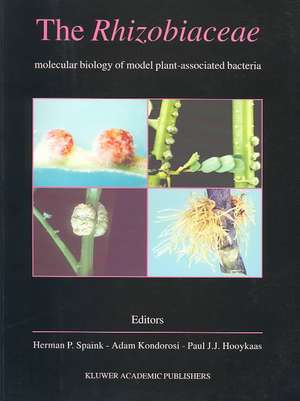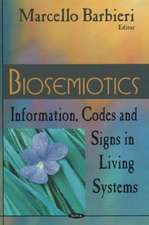The Rhizobiaceae: Molecular Biology of Model Plant-Associated Bacteria
Editat de Herman P. Spaink, Adam Kondorosi, Paul J.J. Hooykaasen Limba Engleză Paperback – 31 iul 1998
Preț: 414.82 lei
Nou
Puncte Express: 622
Preț estimativ în valută:
79.39€ • 82.25$ • 66.25£
79.39€ • 82.25$ • 66.25£
Carte tipărită la comandă
Livrare economică 18-24 martie
Preluare comenzi: 021 569.72.76
Specificații
ISBN-13: 9780792351801
ISBN-10: 0792351800
Pagini: 566
Ilustrații: XXIV, 566 p.
Dimensiuni: 195 x 260 x 32 mm
Greutate: 1.01 kg
Ediția:Softcover reprint of the original 1st ed. 1998
Editura: SPRINGER NETHERLANDS
Colecția Springer
Locul publicării:Dordrecht, Netherlands
ISBN-10: 0792351800
Pagini: 566
Ilustrații: XXIV, 566 p.
Dimensiuni: 195 x 260 x 32 mm
Greutate: 1.01 kg
Ediția:Softcover reprint of the original 1st ed. 1998
Editura: SPRINGER NETHERLANDS
Colecția Springer
Locul publicării:Dordrecht, Netherlands
Public țintă
ResearchCuprins
1. Molecular Evolutionary Systematics of the Rhizobiaceae.- 2. General Genetic Knowledge.- 3. Outer Membrane Proteins.- 4. Phospholipids and Alternative Membrane Lipids.- 5. Cell-surface ?-glucans.- 6. Production of Exopolysaccharides.- 7. Lipopolysaccharides and K-Antigens: Their Structures, Biosynthesis and Functions.- 8. Soil Biology of the Rhizobiaceae.- 9. Opines and Opine-Like Molecules Involved in Plant-Rhizobiaceae Interactions.- 10. Conjugal Plasmids and Their Transfer.- 11. Attachment of Rhizobiaceae to Plant Cells.- 12. The Agrobacterium Oncogenes.- 13. Organization and Regulation of Expression of the Agrobacterium Virulence Genes.- 14. Function of the Ti-Plasmid Vir Proteins: T-Complex Formation and Transfer to the Plant Cell.- 15. Role of Virulence Proteins of Agrobacterium in the Plant.- 16. Determinants of Host Specificity of Agrobacterium and their function.- 17. The Use of Agrobacterium for Plant Genetic Engineering.- 18. Diversity of Root Nodulation and Rhizobial Infection Processes.- 19. Genetic Organization and Transcriptional Regulation of Rhizobial Nodulation Genes.- 20. Functions of Rhizobial Nodulation Genes.- 21. Responses of the Plant to Nod Factors.- 22. Tissue and Cell Invasion by Rhizobium: The Structure and Development of Infection Threads and Symbiosomes.- 23. A Survey of Symbiotic Nitrogen Fixation by Rhizobia.- 24. Carbon and Nitrogen Metabolism in Rhizobia.- 25. Evolutionary Aspects of Symbiotic Adaptations, Rhizobium’s Contribution to Evolution by Association.- 26. Legume Symbiotic Nitrogen Fixation: Agronomic Aspects.- Contributors.- Abbreviations.





